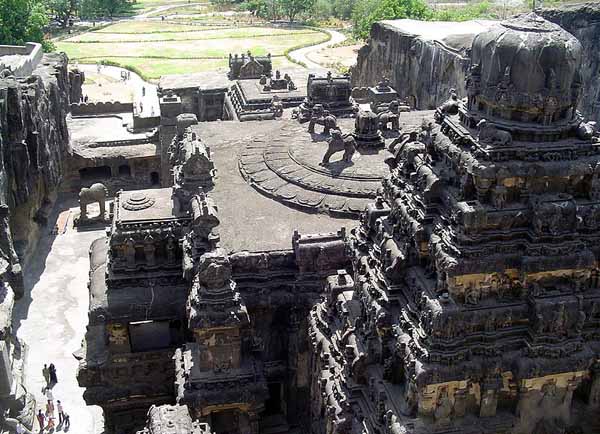While the earliest rock-cut “caves” in India appear around 100 BC, the first of the 34 caves at Ellora were excavated around AD 550. These elaborate caves were Buddhist devotional sites. During the mid-700s AD, the ruling Rashtrakuta dynasty began work on some of the most amazing and ambitious Hindu rock-cut architecture in all of India.
Shiva and Mount Kailasa
Lore states that the god Shiva—a divine yogi, a dancer and a ferocious enemy of demons—resides high on Mount Kailasa in the Himalayan mountains. It was here that the Lord Shiva quelled the demon Ravana, who was shaking his mountain home. By placing just one toe on the earth, Shiva stopped the quaking and restored peace.
The Rameshvara temple (Cave 21) at Ellora is not the most well-known, but houses some of the finest and most interesting Indian Shaiva sculpture. Inside the large pillared hall are a series of sub-shrines displaying stories from Shiva’s mythology. A panel showing Shiva’s marriage is framed below by a fanciful frieze of Shiva’s dwarves (ganas). Another panel shows Shiva in his popular form as the cosmic dancer or the Lord of the Dance (Shiva Nataraja). The detailed carving of his matted locks piled on top of his head, and his deceptively nonchalant expression, as well as the individuality of posture and face in the musicians and onlookers marks a high point in Indian sculptural art.
The Kailasanatha Temple at Ellora
The Kailasa (or Kailasanatha) temple is a major feat of ancient engineering and sculpture. After digging a 300-ft-deep trench into the rocky hill, artisans shaped a 200 by 100 foot temple out of the remaining “island” of rock. More sculpture than architecture, this temple dedicated to Shiva was literally carved out of a solid hunk of stone.
The temple mirrors trends in the architecture of more traditionally built temples of the time, with a main temple, a gatehouse and a shrine for Shiva’s bull vehicle—Nandi. Perhaps most charming are the series of nearly life-size stone elephants, whose backs support the stone structures. While the bottom levels of the buildings are solid, the upper levels are hollowed out as regular buildings and may be entered by stairs or by connecting stone bridges that link one structure to the next.
Surfaces of the temple are covered with detailed sculptural panels of Shiva’s exploits, as well as images of other gods and goddesses. Of particular note, and of great testament to the ancient India artists’ skills, is the panel depicting Ravana shaking Mount Kailasa. As Shiva and his wife Parvati sit atop the mountain with their servants, the multi-headed, multi-armed demon shakes it from below. The demon’s figure appears in a deep darkened hollow and his body is partly carved in the round, enhancing the shadowed effect.
Indian Art & World Heritage
Ellora was named a UNESCO World Heritage site in 1983. Besides being a major tourist attraction, this site is a valuable resource for artists, architects and archaeologists. It is one of many World Heritage sites located in India–a country that holds a wealth of information about ancient history, too little taught about and appreciated in the West.
Sources:
- Dehejia, Vidya. Indian Art. Phaidon Press, 1997.
- Huntington, Susan. The Art of Ancient India. Weatherhill, 1985.








